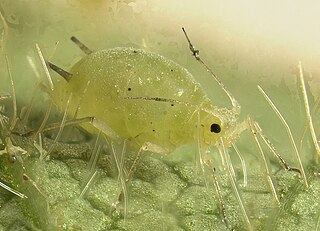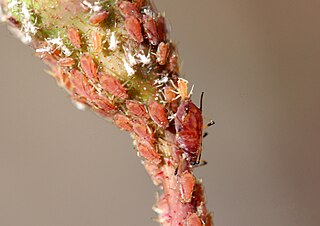Related Research Articles

Aphids are small sap-sucking insects and members of the superfamily Aphidoidea. Common names include greenfly and blackfly, although individuals within a species can vary widely in color. The group includes the fluffy white woolly aphids. A typical life cycle involves flightless females giving living birth to female nymphs—who may also be already pregnant, an adaptation scientists call telescopic development—without the involvement of males. Maturing rapidly, females breed profusely so that the number of these insects multiplies quickly. Winged females may develop later in the season, allowing the insects to colonize new plants. In temperate regions, a phase of sexual reproduction occurs in the autumn, with the insects often overwintering as eggs.

The Aphididae are a very large insect family in the aphid superfamily (Aphidoidea), of the order Hemiptera. Several thousand species are placed in this family, many of which are well known for being serious plant pests. They are also the family of insects containing most plant virus vectors with the green peach aphid being one of the most prevalent and indiscriminate carriers.
Barley yellow dwarf (BYD) is a plant disease caused by the barley yellow dwarf virus (BYDV), and is the most widely distributed viral disease of cereals. It affects the economically important crop species barley, oats, wheat, maize, triticale and rice.
Citrus tristeza virus (CTV) is a viral species of the genus Closterovirus that causes the most economically damaging disease to its namesake plant genus, Citrus. The disease has led to the death of millions of Citrus trees all over the world and has rendered millions of others useless for production. Farmers in Brazil and other South American countries gave it the name "tristeza", meaning sadness in Portuguese and Spanish, referring to the devastation produced by the disease in the 1930s. The virus is transmitted most efficiently by the brown citrus aphid.

Coccinella transversalis, commonly known as the transverse ladybird or transverse lady beetle is a species of ladybird beetle found from India across southern and southeastern Asia to Malesia and Australia. It is not to be confused with Coccinella transversoguttata, a widespread species in Europe and North America also known as the transverse ladybird. The alternative vernacular of small transverse ladybird may be used for C. transversalis in instances where these two species are discussed together.

Rhopalosiphum maidis, common names corn leaf aphid and corn aphid, is an insect, and a pest of maize and other crops. It has a nearly worldwide distribution and is typically found in agricultural fields, grasslands, and forest-grassland zones. Among aphids that feed on maize, it is the most commonly encountered and most economically damaging, particularly in tropical and warmer temperate areas. In addition to maize, R. maidis damages rice, sorghum, and other cultivated and wild monocots.

Phylloxeridae is a small family of plant-parasitic hemipterans closely related to aphids with only 75 described species. This group comprises two subfamilies and 11 genera with one that is fossil. The genus type is Phylloxera. The Phylloxeridae species are usually called Phylloxerans or Phylloxerids.

Macrosiphini is an aphid tribe in the subfamily Aphidinae.

The Ornate Aphid, or Violet aphid,, is an aphid in the superfamily Aphidoidea in the order Hemiptera. It is a true bug and sucks sap from plants. It is an invasive species.

Pentalonia nigronervosa is an aphid in the superfamily Aphidoidea in the order Hemiptera. It is a true bug and sucks sap mainly from Musa species.

The English Grain Aphid is an aphid in the superfamily Aphidoidea in the order Hemiptera. It is a true bug and sucks sap from plants. It lives on grasses, sedge and rushes and can be a significant pest of cereals.
The Indian Grain Aphid, also known as Sitobion (Sitobion) miscanthi, is an aphid in the superfamily Aphidoidea in the order Hemiptera. It is a true bug and sucks sap from cereal plants, making it a pest of wheat production. A high-quality draft of the S. miscanthi genome 377.19 Mb in size was sequenced to help promote research on the lifestyle and feeding specificity of aphids and their interactions with each other and species at other trophic levels.
The Paulian Grain Aphid,, also known as Sitobion (Sitobion) pauliani, is an aphid in the superfamily Aphidoidea in the order Hemiptera. It is a true bug and sucks sap from plants.
Sitobion phyllanthi, also known as Sitobion (Sitobion) phyllanthi, is an aphid in the superfamily Aphidoidea in the order Hemiptera. It is a true bug and sucks sap from plants.
The Sugarcane Woolly Aphid,, is an aphid in the superfamily Aphidoidea in the order Hemiptera. It is a true bug and sucks sap from plants. It is a foliage sucking aphid species.
The Bamboo Woolly Aphid,, is an aphid in the superfamily Aphidoidea in the order Hemiptera. It is a true bug and sucks sap from plants.

Tetraneura is a genus of woolly and gall-making aphids in the family Aphididae. There are at least 30 described species in Tetraneura.
Sitobion luteum, the orchid aphid, is a species of aphid in the family Aphididae. It is found in Europe.

Sitobion is a genus of aphids in the family Aphididae. There are more than 80 described species in Sitobion.
References
- http://animaldiversity.org/accounts/Sitobion_lambersi/classification/
- http://aphid.speciesfile.org/Common/basic/Taxa.aspx?TaxonNameID=1168830
- http://www.agroatlas.ru/en/content/pests/Sitobion_avenae/
- http://entoweb.okstate.edu/ddd/insects/englishgrainaphid.htm
| | This article related to members of the insect family Aphididae is a stub. You can help Wikipedia by expanding it. |